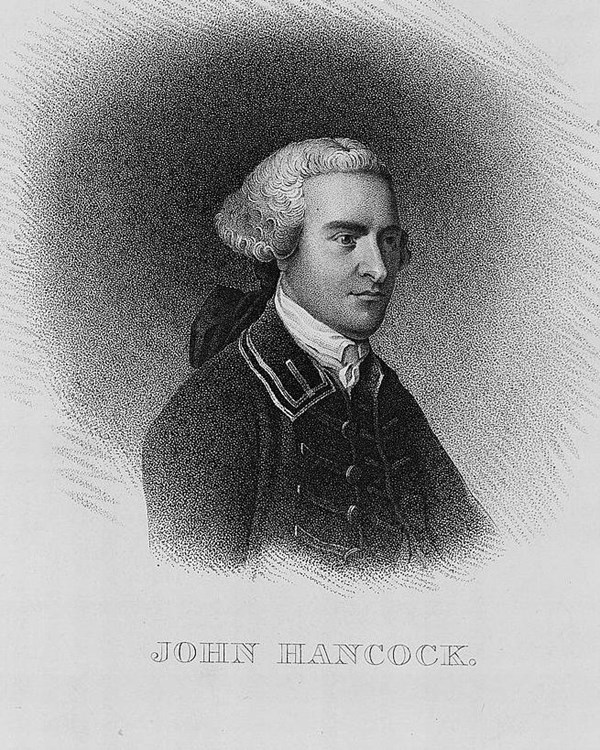Last updated: February 21, 2025
Person
John Hancock

Library of Congress
"Some boast of being friends to government; I am a friend to righteous government, to a government founded upon the principles of reason and justice; but I glory in publicly avowing my eternal enmity to tyranny."1
John Hancock spoke these words during the 1774 Boston Massacre commemoration at Faneuil Hall. Hancock was considered an odd choice for speaker. Despite being one of the wealthiest and most popular men in Boston, Hancock was not renowned for his oratory or writing skills. His popularity meant the people of Boston liked John Hancock and wanted to hear him speak regardless of his skill.2 Hancock leveraged his wealth into being a central part of the growing Revolutionary movement, and one of the most popular figures in Massachusetts.
Rising to such prominence, however, required no small amount of privilege. John Hancock inherited his wealth from his uncle, Thomas Hancock, in 1764. John Hancock’s father had passed away when Hancock was seven, making his uncle Thomas his caretaker. After his uncle’s passing, and John Hancock’s inheritance of his uncle’s lucrative business, the young John Hancock won an election to become one of the town’s selectmen.3
As a merchant and politician, Hancock developed a personal interest in the new taxes Britain had developed. He participated in the boycotts that came with the Stamp Act and the Townsend Acts. His business became a political flashpoint in 1768, when British customs officials seized one of his sloops, the Liberty. The customs agents accused Hancock of smuggling and, after a highly publicized trial, the charges were dropped without explanation, likely due to lack of evidence. While no legal repercussions came of the case, its publicity helped Hancock cement his position amongst the revolutionaries.4
When a Town Meeting met in Faneuil Hall to discuss the Tea Act in 1773, Hancock served as the moderator. The declared sentiment, that any who purchased tea was ‘An Enemy of America,’ led to the Boston Tea Party.5 In retaliation to the destruction of the tea, Governor Thomas Gage dissolved the Provincial Assembly. The members of the assembly instead met in Concord, creating the Provincial Congress to act as the government of Massachusetts in place of Gage. Almost immediately, Hancock was elected president of this new institution.
With his new leadership position in a now autonomous government, Hancock moved to Lexington alongside his long-time associate Samuel Adams. In April 1775, the British marched on Concord. Hancock and Adams fled, fearing arrest. Hancock’s escape culminated in his arrival in Philadelphia, where he joined the Continental Congress.6
Hancock’s reputation preceded him. The Continental Congress swiftly and unanimously elected him President in 1775. He retained the position for the signing of the Declaration of Independence a year later.7 As President, Hancock signed the document first to ratify it. Early public versions of the document only bore his name. Hancock’s name and the Declaration became inextricably linked, with Hancock’s signature becoming his most famous trait, despite his lengthy political and business career.8
Hancock only served as President for two and a half years. He returned to Massachusetts in 1777, though he rejoined the Continental Congress temporarily in 1778. He went on to win the governorship of Massachusetts from 1780 until 1785, when he announced his retirement. His retirement only lasted a year before he reclaimed the office in 1786. Hancock served as governor of Massachusetts until his death in 1793.9
Footnotes:
- John Hancock, An Oration Delivered March Fifth, 1774 (Boston: Edes and Gill, 1774) 6. Accessed July 2021, https://www.masshist.org/dorr/volume/4/sequence/1282.
- “‘My Sincere Attachment to the Interest of My Country,’” Accessed June 25, 2021, http://boston1775.blogspot.com/2021/03/my-sincere-attachment-to-interest-of-my.html.
- F.W.B. “AN HISTORICAL SKETCH,” The Aldine Press 2, no. 5 (May 1869), https://www.jstor.org/stable/43243102.
- Donald Proctor, “John Hancock: New Soundings on an Old Barrel,” The Journal of American History 64, no. 3 (December 1977): 652–77.
- William Fowler, The Baron of Beacon Hill: A Biography of John Hancock (Boston: Houghton Mifflin Company, 1980) 156, Accessed July 2021, https://archive.org/details/baronofbeaconhil0000fowl/mode/2up.
- Fowler, 177; 181-187.
- Proctor, 653.
- F.W.B. “AN HISTORICAL SKETCH.”
- F.W.B. “AN HISTORICAL SKETCH.”
